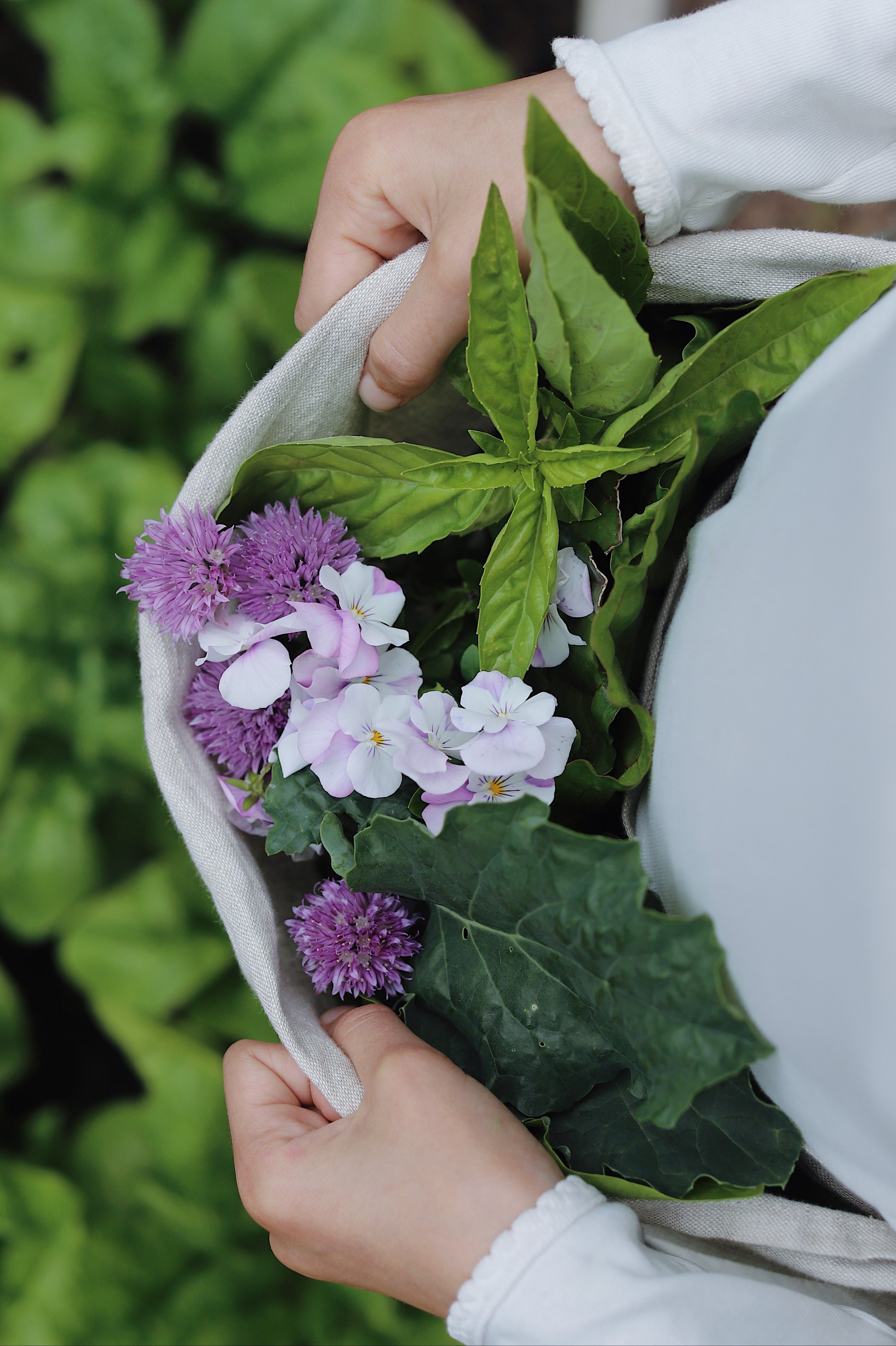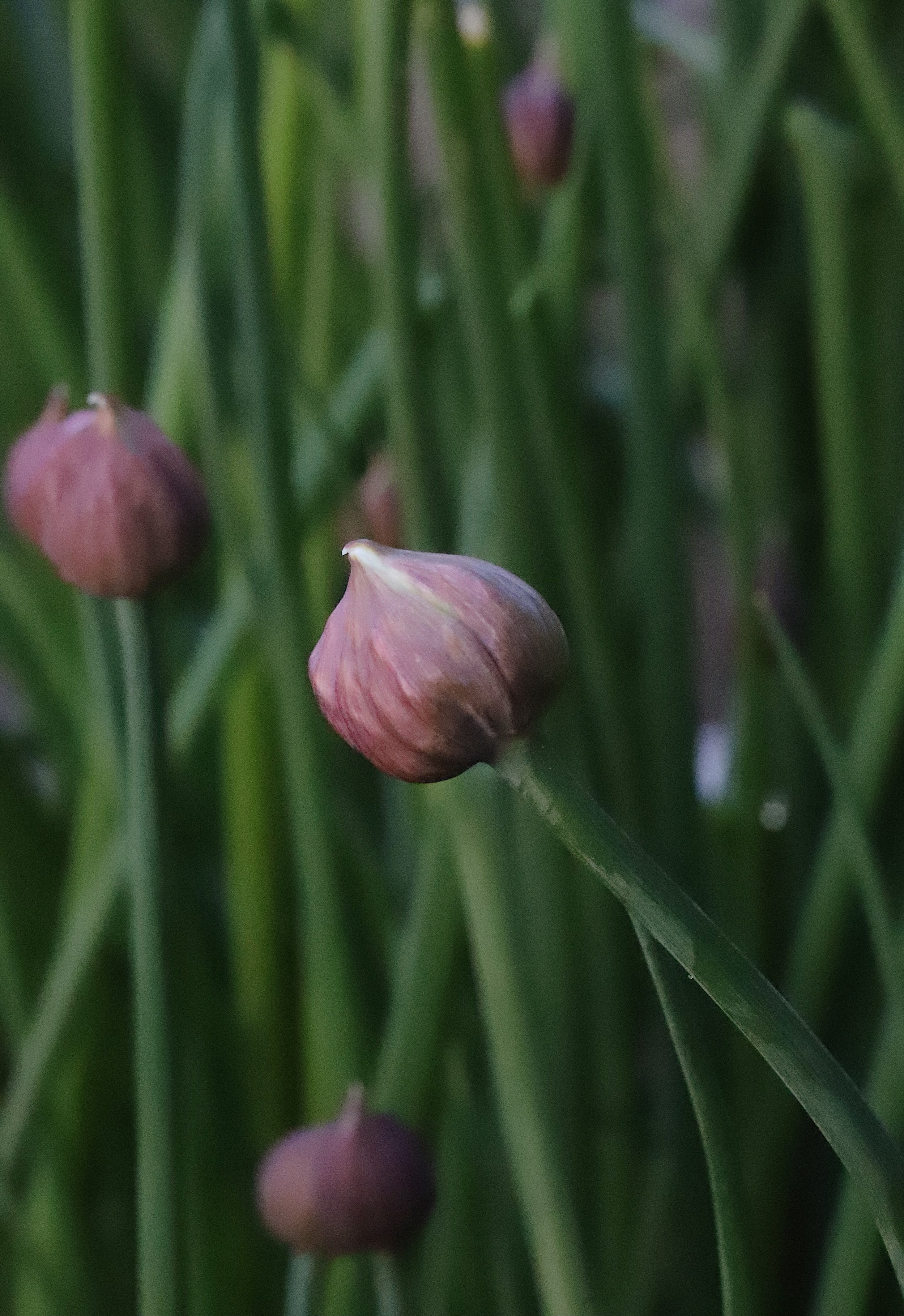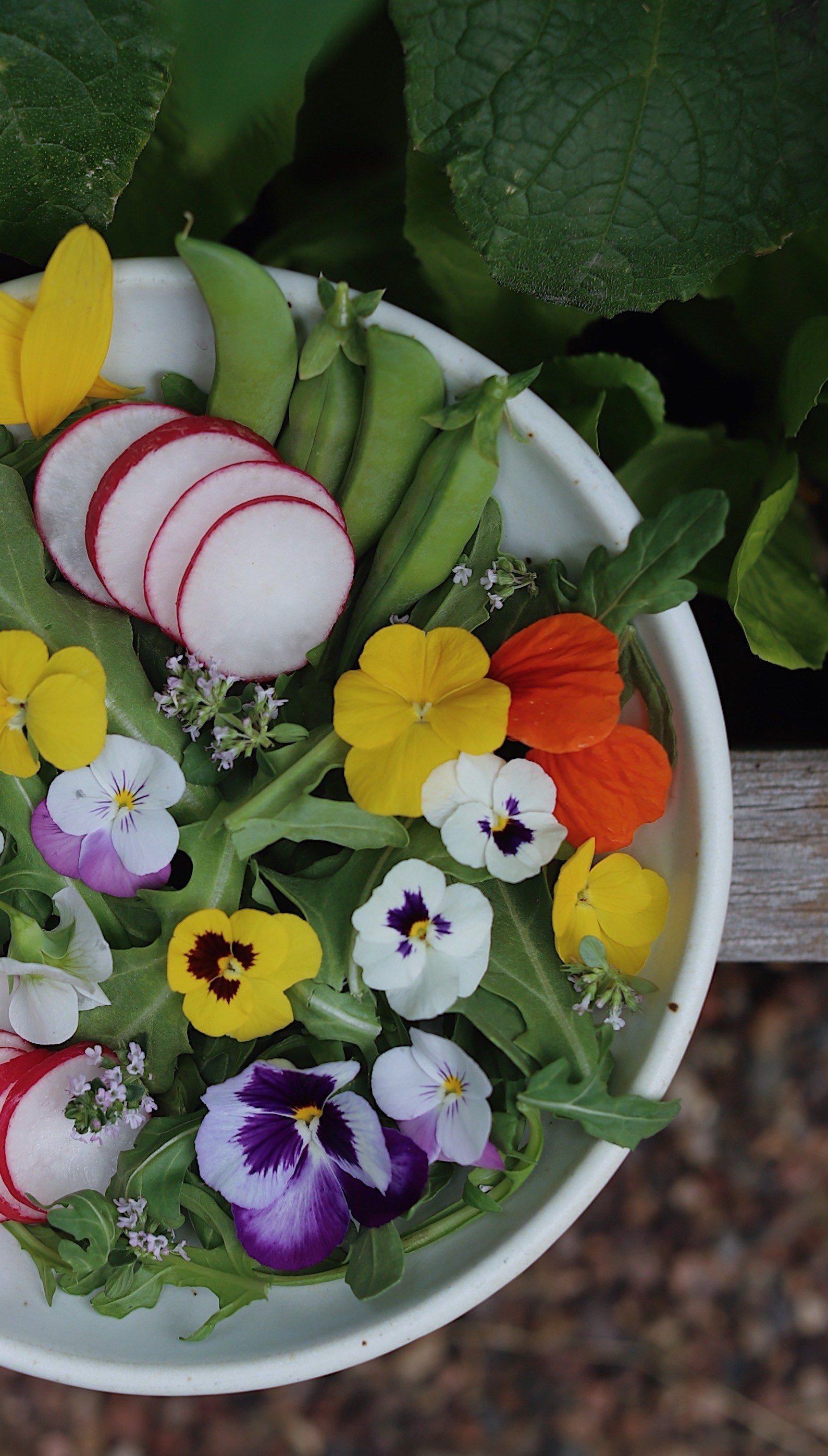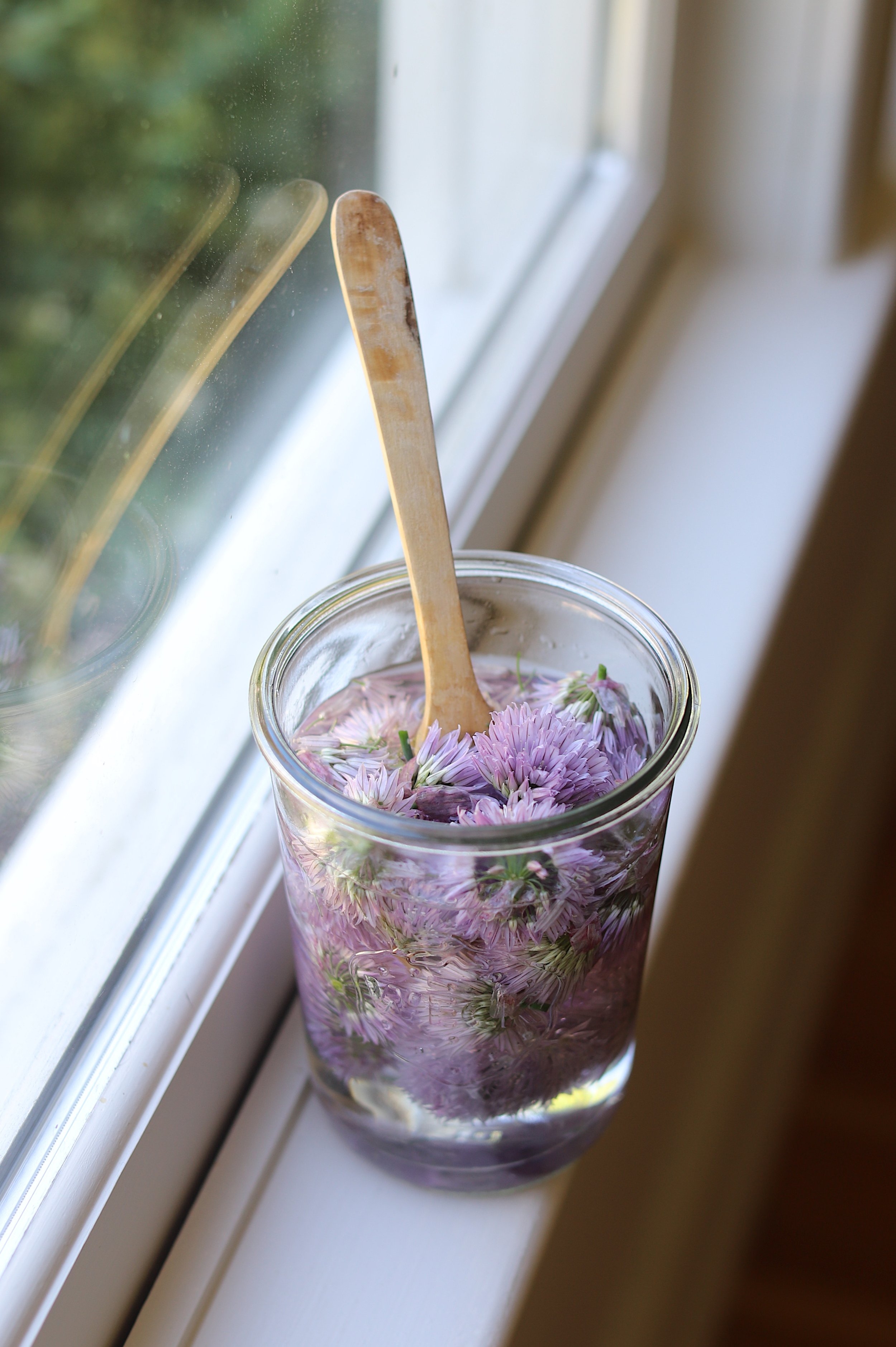My Favorite Edible Flowers
They say edible flowers are making a comeback, but for some of us they never went away.
Even before many of us could say our ABCs, we were foraging for flowers we could eat fresh outdoors. In South Carolina, where I grew up, every kid I knew could identify honeysuckle by sight and smell. While living in California, my children filled their bellies with pea flowers from our garden and picked borage from the courtyard of our favorite restaurant in Stinson Beach.
It’s funny, but I think a lot of us, especially those of us who grew up playing outdoors, know much more about plants than we realize. As a six year old, I somehow knew that dandelions were as useful for braiding crowns as they were for brewing tea. I also remember eating pansies off of my grandparents 50th wedding anniversary cake and harvesting chamomile for tea at summer camp in the Blue Ridge Mountains.
I think flowers, especially edible ones, have always had a hold on children. But something I’ve come to realize is that the natural connection children have with plants doesn’t disappear with age. Recently, as I’ve added edible flowers to my garden, I’ve noticed I’m every age I’ve ever been. The 4 year old in me that used to decorate mud pies with pansies is just as delighted to press them into sugar cookies. The 6 year old in me that mixed mud and flowers to make potions is ever giddy to use lilacs to flavor lemon water.
And when I look around my yard, I’m more than a little chuffed by the hodgepodge of edible flowers growing around me. The climbing roses making their way up the arbor in our front yard, the lilacs lining the north side of our picket fence, the dandelions springing up on our natural, unsprayed lawn - they’re all vying for a place in my kitchen where they’ll be tossed into syrups, pastries, and jellies.
Below are some of my favorite, easy to grow edible flowers, with suggestions for ways to cook, bake, or drink them. But before I jump in, here are a few important guidelines for growing and harvesting them:
1. Before you consume a flower (or any plant), be certain it’s safe to eat. Remember that not all flowers are edible and some are poisonous.
2. Avoid buying edible plants as seedlings from nurseries unless you can be 100% sure they’re organic. Since most commercially-grown plants are sprayed, your safest bet is to grow edible flowers from seed yourself.
3. Never harvest flowers growing near roads, railroads, or power lines, as the surrounding soil is usually contaminated with lead, herbicides, and other toxins.
4. Harvest flowers on warm dry mornings, before the sun gets too strong and draws out the essential oils. They’re best picked freshly opened, when their scent and flavor are at their peaks.
5. Harvest respectfully - always leave some flowers for biodiversity and for the plant’s longevity.
6. To clean flowers, use a delicate pastry brush to wipe off any residue or insects. Try to do this outside so the bugs can escape unscathed and go on their merry way!
7. if you have pollen allergies remove the stamens or pistils from flowers before eating.
8. For safety’s sake, eat only flower petals as other parts are often inedible.
Now for my favorite edible flowers and fun ways to use them.
Anise hyssop.
Anise hyssop is a perennial herb in zones 4-9 and a favorite of pollinators and gardeners alike. It can grow tall and woody with flowers blooming in lavender, pink white, and blue. The flowers and leaves are both edible and have a lightly minty, subtly licorice taste. You can use the flowers to garnish salads, soups, or pasta, and the leaves and flowers make a delicious black licorice flavored tea, which is sometimes used by herbalist to help relieve congestion. Dried, the flowers make a lovely potpourri that can be used to make dream pillows. According to folklore, anise hyssop prevents nightmares and promotes sweet dreams.
Bee Balm
Also known as bergamot, bee balm is a perennial in zones 3-9. It grows in clumps up to 2’ to 4’ tall and is easily recognized by its cheerful, firework-esque blooms. Bee balm flowers are revered for being edible but they’re also appreciated for their ability to attract pollinators and birds to the garden. As a member of the mint family, it has a citrusy aroma with a minty flavor (no surprise there!). Historically, the leaves and flowers were used by Native Americans to make an herbal tea called Oswego tea, which they used to treat coughs, colds, fevers, and stomach-aches, but nowadays the blooms are mostly used to garnish salads, desserts, and beverages. Dried bee balm also makes a wonderful culinary spice that is often used in place of oregano or thyme.
Borage
Borage is a fuzzy leaved herb native to the Mediterranean. Also known as starflower, it’s an easy, fast growing annual with vivid blue flowers and the flavor and scent of cucumbers. Although considered an herb, it’s often grown as a flower in the vegetable garden, where it acts as an excellent companion to tomatoes, strawberries, and squash. Borage is also great at attracting pollinators - bees in particular can’t get enough of it! Borage grows readily from seed and can be sown directly in the ground. While people sometimes eat the leaves, technically they are toxic to people and animals. Because they taste like cucumbers, borage flowers are excellent tossed in salads and cocktails. My children like to freeze the tiny flowers in ice cubes and add them to lemonade.
Calendula
As a family, calendula includes 20 species of bushy annuals and a few perennials that do it all: attract pollinators, repel pests, make medicine, dye fabric. They’re also edible of course! Commonly known as pot marigolds (though not at all related to other popular marigolds), calendula is easy to grow from seed and makes an excellent companion plant to cucumbers, tomatoes, peas, carrots, and asparagus. If you cut them back, they’ll continue to bloom from early summer to late fall. Uncooked, calendula petals have a subtle, slightly spicy taste. I like to separate the petals from the center of the flower and sprinkle them on salads, but you can also cook them in olive oil to add a saffron taste to dishes. As a natural dye, calendula produces hues ranging from light yellow to olive brown and light brown.
Chamomile
There are two types of chamomiles: German and Roman. Both are native to Europe and both have medicinal properties. They also both have fragrant, daisy-like flowers with white petals encompassing a yellow center. German and Roman chamomile both grow quickly and are best planted in the spring, either by seed or as transplants. Roman chamomile is typically used as a ground cover while German chamomile is grown for tea. German chamomile is what I grow. It’s an annual but self-seeds so readily, you would think it’s a perennial! The best way to grow chamomile is to start it from seed indoors about six weeks before the last frost date. Chamomile seeds need light to germinate, so scatter the seeds and press them firmly into the soil, but don’t cover them with soil. After the all danger of frost has passed, you can plant them in the garden. Chamomile flowers have an apple-like flavor and can be used fresh or dried to make tea.
Chives
Chives are a cool-season perennial and a member of the onion family. They grow purple edible flowers and act as a wonderful companion plant to carrots, celery, lettuce, peas, and tomatoes, mostly by helping to deter pests. Be careful where you plant them as they’ll take over it you allow them to go to seed. That said, you can easily dig them up and transplant them elsewhere if they start to take up too much space. You can sow seeds directly in the garden as soon as the soil is workable in the spring, Chive flowers have a light onion-y flavor that can be used in a variety of ways: sprinkled on top of eggs or savory crepes; mashed into butter or cream cheese; added to potato or green salads; tossed into salad dressings; or used as a garnish for soups and stews. Chive blossom infused vinegar is a personal favorite of mine!
Nasturtium
Nasturtium are a cheerful and easy-to-grow flower that blooms for months on end. With their unique greenery, bright flowers and rambling stems, they look great along the edges of raised beds or large containers. They’re also often used as a trap crop in companion planting, drawing aphids and other garden pests away from nearby vegetables. Nasturtium is a friend of beans, broccoli, cabbage, cucumber, kale, melon, pumpkin, and radish. Pests aren’t the only thing nasturtium attract. They’re also a favorite of pollinators like bees and butterflies. Nasturtium are grown as annual plants in most places although they’ll grow as perennials in frost-free zones. In terms of edibility, nasturtium’s leaves and flowers can be eaten and have a peppery, almost mustard-like taste. I like to add them to salads, but they can also be added, chopped, to vinaigrettes, sauces, and dips. You can also stir fry the leaves, just as you would any green, or add them to green smoothies that call for spinach and the like.
Pansies
Pansies are one of the most popular edible flowers, both because you can eat their sepals, but also because they come in such a variety of colors. Pansies are a versatile, cool-season flowers that grow in full to partial sun when temperatures stay between 40 degrees F and 60 degrees F during the day. This makes them ideal for spring and fall gardens. Although they’re technically biennials, they’re typically grown as annuals. Pansies can be easily purchased from most garden stores, but since they’ve likely been sprayed, you’ll need to start them yourself from seed! Pansies have a mild evergreen flavor that lends itself well to salads, drinks, and desserts. Unlike most edible flowers, you can eat the entire pansy flower - sepals and all. I like to use pansies to decorate cakes and cookies (their flat shape makes them ideally suited for decorating), but they’re also a perfect addition to herb-flavored cocktails and fruit and green salads. For a quick snack you can also spread cream cheese on a cracker and top it with a whole pansy.
Squash blossoms
Squash blossoms are simply the flowers of summer or winter squash. You can eat them raw, dipped in batter and friend, stuffed with cheese and baked, or served over pasta or inside a quesadilla. Note, squash flowers grow male and female flowers, both of which are edible. BUT, you’ll want to leave enough female flowers on the plant to ensure that it produces at least some fruit. If you harvest all them, you won’t have any squash to harvest. Harvest flowers midday when they’re still open, cutting the stem one inch below the flower. Gently rinse them in a container of cool water and store them in a container of ice in the refrigerator, where they’ll stay fresh for up to a day.
Marigolds
Marigolds are one of the most common annual flowers. Not only do they bloom for months on end, but they also add a nice pop of color to the garden. They also repel pests, can be used as a natural dye, and can be enjoyed in foods and beverages. As an edible flower, they’re often used to add a saffron-like color and a mildly-citrusy taste to dishes. Marigolds are easy to grow and can be started from seed indoors 6-8 weeks before the last frost date. They also self-sow and will often repopulate an area with their seeds. Caring for marigolds is easy too. Just keep them consistently watered and deadhead their blossoms for a consistent harvest. When you’re ready to eat them, add them to salads, soups, stir fries, and pastas. They may not taste like much, but they’re definitely a feast for the eyes! Take note though: although all marigolds are edible, not all of them taste great. For taste, I recommend French marigolds, Gem marigolds, and Mexican mint marigolds.
Other edibles I love include: bergamot, chervil, chrysanthemum, cornflower, dandelions, dianthus, hibiscus, hollyhock, honeysuckle, johnny-jump-ups, lavender, mums, roses, scarlet runners, sunflowers, and violets.






